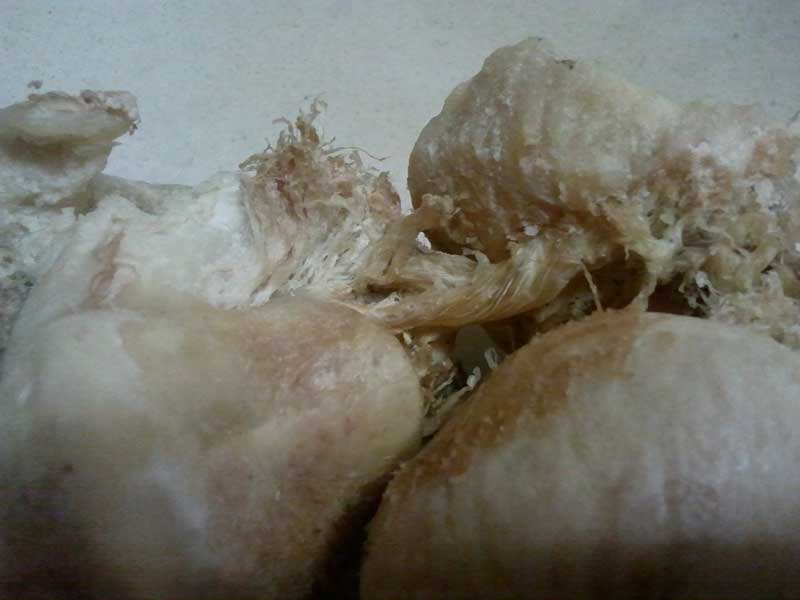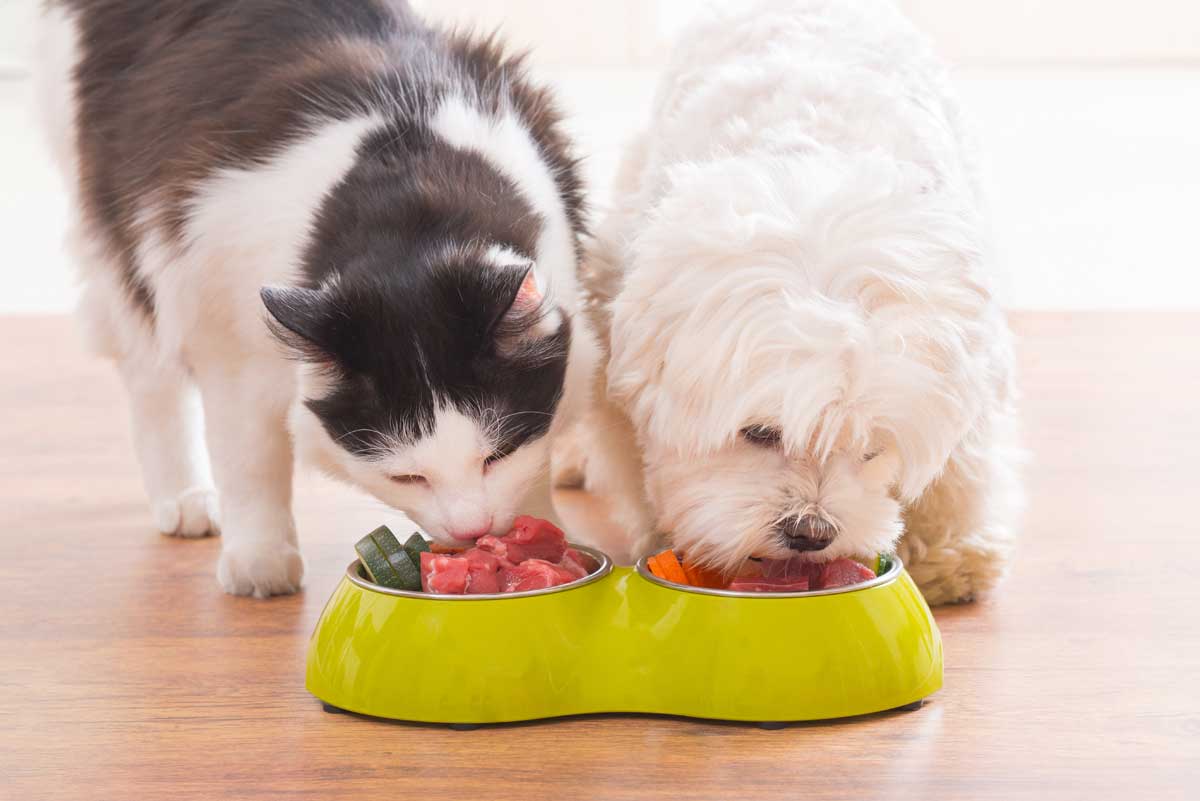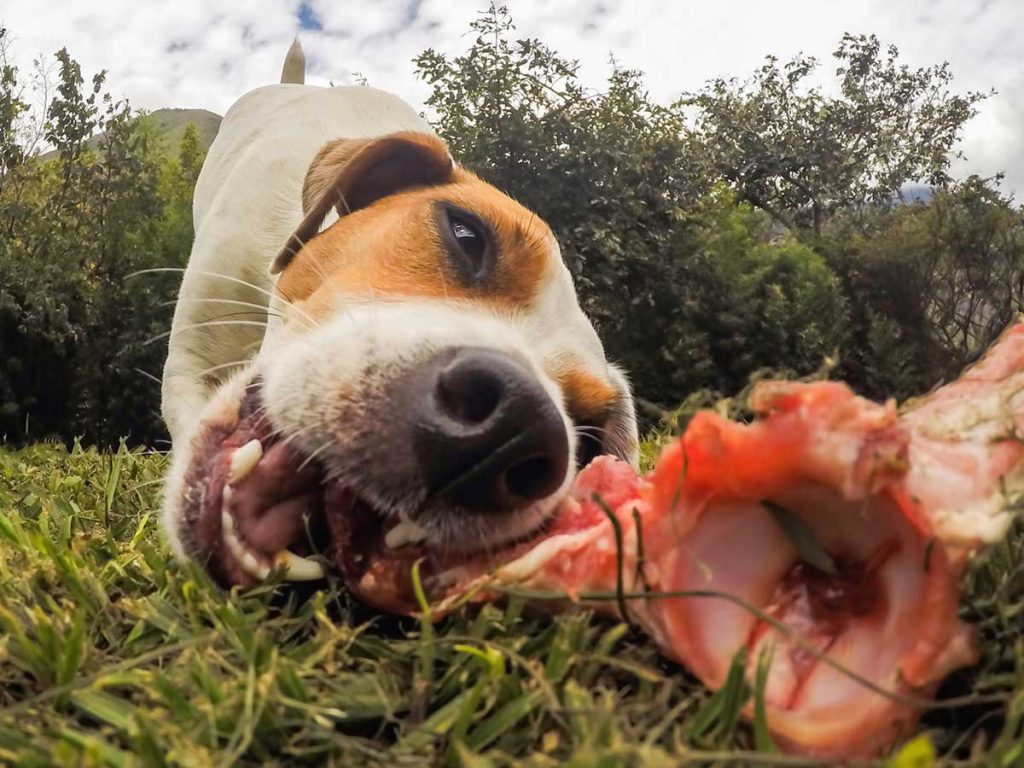Natural Pet Health, Pet Nutrition
Raw Food Diet – is it the best thing for your dog?
Few things connect us with nature and a more natural way of living more than our diet and a raw food diet is exactly what our dogs would eat in the wild. Unfortunately, the diet of the average Westerner is far removed from that of our ancestors, with a recent global health study showing that one in five deaths around the world is caused by a bad diet, with obesity the fastest growing global risk. Only 20% of Americans eat as many as five pieces of fruits and veggies a day and in the UK it is expected that by 2035 one in ten adults will have diabetes. The respected American author, journalist and activist Michael Pollan said “Don’t eat anything your great-grandmother wouldn’t recognize as food.” While this is a powerful concept that we all would undoubtedly benefit from abiding by, could it also be applied to our dogs? The answer undoubtedly is yes. A raw food diet is the closest to a natural diet for carnivores that we can achieve and dogs and cats that eat a natural diet live longer, healthier lives. The problem is that (like in our own diets) we have largely lost touch with what a natural diet is and the vast majority of dogs are fed the canine equivalent of junk food. Our supermarket and pet store aisles are laden with beautifully packaged boxes and bags that make inspiring promises such as ‘nutritionally complete’, ‘natural’ and ‘performance’, with images of beautifully groomed, healthy dogs living life to the fullest. But natural food doesn’t come pre-packaged in vacuum-wrapped foil – we’re finally starting to realise this with our own food and it’s time that we did for the benefit of our dogs too. In this post, Tom Farrington MVB MRCVS VetMFHom – Chief Veterinary Medical Advisor for HomeoPet – gives an overview of what a raw food diet is and why you should feed it to your dog.
What is a raw food diet for dogs?
Raw diets also go by the acronym BARF. While this may give the wrong impression of this healthy approach to feeding your dog, it actually stands for Bones And Raw Food or as I prefer a Biologically Appropriate Raw Food Diet. A raw food diet is surprisingly simple, comprising approx. 80% raw, lean-ish meat and 20% grated or pureed raw vegetables (except potato) or even a little fruit. The meat comprises simply of meaty bone (such as chicken wings or legs) with minced meat of any kind, such as diced beef. Some good oils like Cod Liver Oil, Flax Oil or Hemp Oil are a great addition, as is kelp, rose hip, alfalfa or brewers yeast. The result is a really balanced diet for your dog, who will undoubtedly reap the benefits. From time to time additions such as soaked gluten-free oats can be useful in dogs which need to gain weight rapidly but are not essential to a healthy diet
Why feed a raw food diet to your dog?
Dogs are carnivores which, by definition, is an animal that eats flesh. Dogs do need a bit of herbage and if push comes to shove they can survive on it, but a flesh-based diet is what a dog’s anatomy is designed for. Dogs have five kinds of exceedingly sharp teeth that would enable them to eat small birds and beasts and a share of larger prey such as sheep or deer. Dogs also eat the whole animal, including its bones, and in the wild up to a third of a dog’s nutrition (including calcium, magnesium, complex fats and vitamins) may come from bones!
Unlike us humans, dogs have no digestive enzymes in their saliva and they cannot move their jaws from side to side. What this means is that they are designed to gulp food straight down the saliva acting mainly as a sticky glupy lubricant, instead of grinding it like is required for the plant matter that a herbivore eats. And then the entire digestive process takes place in their large, expandable stomachs. While all the above clearly demonstrates that a dog should eat a diet comprised primarily of meat, what about the raw aspect? The reality is that when food is cooked, its chemical structure is altered and from a dog’s perspective, about 70% of its nutritional value is lost and this must then be added back into the food through supplementation. For example, the amino acid Taurine is very easily destroyed by cooking and as a result, dogs need their food served raw in order to digest it properly and to get the most nutritional value from it.
What is wrong with processed dog food?
We are seeing more and more illnesses in our dogs and they just do not have the lifespan that they had decades ago. A multitude of health problems can be attributed to a less than natural diet and research is showing that the development of all sorts of genetic conditions may also be attributable to generations of dogs eating a harmful diet. But with all the promises that pet food manufacturers make about their dog food, why exactly is processed food bad for our dogs?
- It is cooked (see above).
- It can contain damaging chemicals such as binders, colouring and preservatives.
- The quality of the ingredients is usually poor, even inexpensive dog food.
- It generally contains a high percentage of grain which, quite simply, dogs cannot easily digest. Grain is unsuitable for the canine digestive system and is one of the main causes of skin allergies, diabetes and flatulence. Many foods marketed as ‘grain free’ substitute beans, peas, potato, carrots and other ingredients which instead break down into sugar when they are cooked and as a result these foods are often very high in hidden sugars, which do not have to be on the label. These ingredients often exceed 40% of a manufactured dog good and can even be as high as 80%.
- It does not clean your dog’s teeth effectively. Eating raw, meaty bones (especially joint bones with sinews ligaments and tendons which act like dental floss) will help keep your dog’s teeth and gums clean because of their mildly abrasive texture and their ability to flex around the teeth, which helps to remove dental plaque throughout the whole mouth. And it has been proven that dogs with healthy teeth live longer. The vast majority of processed dog food will contribute in no way to your dog’s oral health and even food marketed as having the benefit of cleaning your dog’s teeth will do little more than remove some of the plaque near the tops of a dog’s teeth and will be largely ineffective within the critical zone near the gumline. And that’s where plaque and tartar cause their most harm — decay (cavities) and gum disease. It’s important to feed meaty rather than clean bones to protect the teeth from damage as your dog chews on the bones. Similarly, with raw chicken wings the meat remains firmly adhered to the bone when raw, whereas it slips off the bone when cooked, leaving the bone completely. Wing bones can easily be cut into smaller pieces for cats and small dogs using a rose secateurs.

BARF cautions
There are cases where you have to be careful in converting your dog onto a BARF diet and the raw food may need to be cooked, for example, for dogs undergoing immunosuppressive therapy like steroids and which can include some chemotherapy cases. However, all these cases can still be tackled with a fresh food diet with no horrible additives.
Bones can be an issue if cooked. The cooking process makes bones more brittle, increasing the likelihood they might splinter and cause internal injury to your dog, whilst cooking can also remove the nutrition they contain. This is why a BARF diet incorporates bones fed with the meat on as this protects the body till the bones are digested. If you feel your dog could be at risk, you can feed minced bone, bone shavings, or even feed it very lightly cooked but not to point meat falls off bones. This is recommended in cases such as for dogs with Cushings disease where your pet may be severely immune suppressed by natural endogenous steroids and where a nick from a sharp bone (or even sharp Kibble) could be fatal.
Hygiene is crucially important in preparing a raw diet for your dog, much as it is when preparing meat for yourself. Use separate storage and preparation areas and separate containers to store and it’s useful to bear in mind that freezing meat and bones before use does reduce possible pathogens. Gloves should be worn during preparation and all instruments and surfaces used should be properly cleaned… nothing that you should not be doing with your own meat preparation!
Tips to get started on a BARF diet
Starting your dog off on a raw food diet can be intimidating. Sure, it’s so easy to buy a brightly packaged box from the supermarket, tear back the foil and your dog can be fed in a matter of minutes. Yet many dogs know this is not good for them and will wait hours before eating them, often leaving them till late at night to see if something better comes along. But just remember all the health implications discussed above of the dangers of processed foods and if there was anything you could do to help keep your dog healthier and happier, you’d do it, right? Well, feeding a BARF diet could be the biggest change you make for the benefit of your dog’s health.
The first thing to do is to find yourself a good butcher, as this will save you a great deal of time and money. Explain what you are doing and ask for scraps, lean mince, inexpensive cuts, offal (heart, kidneys and liver), green tripe, raw, meaty bones and chicken and other carcasses.
Vegetables should always be fresh and realistically any vegetables (except raw potatoes) will do (but in dogs with sugar related issues such as ear problems avoid high sugar vegetables such as carrots). Grate in the vegetable or put it through your food mixer and mix in well to your chosen raw meat. If you are going to make your food up yourself, it will save a lot of time to prepare a large supply in advance and freeze it.
Alternatively, there are an increasing number of companies supplying healthy, nutritious and conveniently prepared raw food diets that your dog will love. If you have any questions about your pet’s health and how a more natural approach to diet and health care could benefit your pet, please contact our Customer Care Line Staff – we’re here to help.





